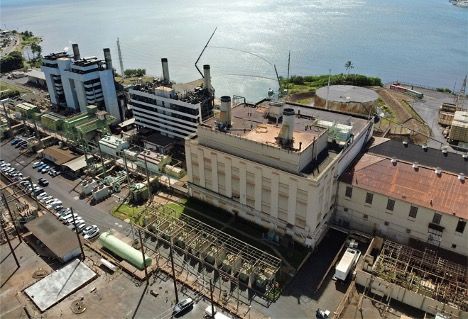Utility Wants To Take Bold Leap Into Sustainable Future

Hawaii's largest electric utility is aiming to convert its 85-year-old oil-burning Waiau power plant to operate on renewable energy by 2029, under a proposal now before the state Public Utilities Commission.
Mike DeCaprio, Hawaiian Electric's vice president of power supply, described the proposed project as "the most impactful transformation of our generation infrastructure in decades."
"It supports the critical need for reliable, 24/7 power that is much more efficient and aligned with our renewable future than the technology it replaces."
Hawai'i Electric Grid Long Dependent On Imported Diesel
The Waiau plant currently consumes almost 74-million gallons a year of petroleum-based diesel, spewing roughly 751,000 metric tons of CO2 a year, according to latest Environmental Protection Agency data.
Hawaii in 2014 became the nation's first to require electric utilities to generate 100 percent of their power from renewables by 2045. But just 17.2 percent of Hawaii's electricity came from renewable sources, with 68 percent from petroleum and 12.6 percent from coal, according to the U.S. Energy Information Administration.
The state in 2021 used the most petroleum for power generation at nearly 415-million gallons than any other in the nation. Louisiana, where the oil and gas industry is king and accounts for 25 percent of statewide revenues, came in second with nearly 100-million gallons less.
Hawaiian Electric currently generates 28 percent of its electricity from sustainable sources on Oahu. That goes up to nearly one-third for the entire state, according to the Associated Press.
Out With Stinky, Toxic Fumes, In With Locally Produced Clean Energy
The utility's proposal aims to swap out aging oil-fired units that date back as far as World War II for smaller, more efficient and quieter generators that can run on a wide range of sustainable energy sources, including, solar and wind power, bio- and renewable diesel and potentially green hydrogen.
Six petrodiesel-fired units built between 1947 and 1969 will be phased out and decommissioned as new renewable-driven capacity becomes available by the end of the decade, under the proposed project.
Move To Sustainable Fuels Means Cleaner Air, Environment On Oahu And Beyond
The change couldn't come soon enough for residents of Oahu and Hawaii at large, where up to 10 percent of adults and children have asthma.
Power generation statewide currently accounts for 31 percent of CO2 emissions. Shifting to renewables could cut air pollution around the plant and beyond by up to 80-100 percent, depending on fuel source.

Better Energy Security, More $$$ For Local Clean Fuel Makers, Cleaner Power For EVs
Transforming the Waiau power plant to run on bio- or renewable diesel or green hydrogen would improve energy independence in Hawaii, where most everything, including oil, must be imported.
Less petroleum demand also means increased economic opportunity for current and future suppliers of renewable fuels.
And a greener, cleaner power generation mix translates into more carbon-free power for the state's growing population of electric vehicles that now run on mostly petroleum-generated electricity.
But, as important, nearby residents can say farewell to the nasty and smelly diesel fumes casting a pall over their community. When combusted, biodiesel, renewable diesel and green hydrogen emit a mild to no odor.
Power Plant Revamp Dependent on Public Utility Commission
Hawaiian Electric's proposal must still get approval from the state PUC, which will consider similar bids from other power companies as well.
A final decision is expected to come in October.
Related Stories:



